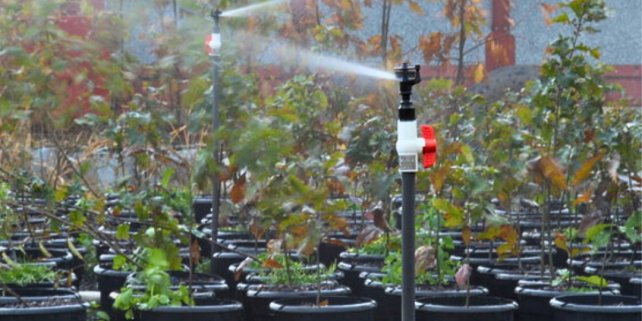Seasonal Considerations
Tips for Watering During Drought

JUNE 23, 2023
It’s official.
Most of Illinois is in severe drought, and it does not look like it is going to lighten up in the near future. Bearing in mind that plants cannot water themselves, we implore happy plant parents and gardeners to do what they can to lessen the stress on the plants in your yard. Although native plants and more established plantings need less water, a drought of this severity means some plants will need our help to make it through. Dig out your sprinklers or make your own! It will become critical to use them in the coming weeks. Here are a couple of tips to help target the more sensitive areas and plants that need the most help.
Make a plan.
Identify the areas of your yard that need help and schedule watering times accordingly. Perennial plantings less than 2 years old and trees and shrubs less than 5 years old will most likely need to be addressed. Longer soaks over the root zones of trees and larger plant beds will be needed at a rate of around once or twice per week, depending on your soil type. New plantings will need water more frequently, every other day or so until they are fully rooted in. Focus on watering areas that heat up fast with regularly planned watering. Plants near sidewalks, driveways, and south-facing walls need to be closely watched and watered. New plants in these areas are prone to wilt and look like they have been put in an oven. So be sure to water them as part of your weekly plan.
Use effective watering techniques.
To get deeper penetration into the soil when watering, you will need to slow the release of the water over a longer period of time to ensure the plant is saturated to the roots. Dumping water all at once will certainly help the plant, but the water may not get to the surrounding soils to improve absorption. Sprinklers, drip lines, soaker hoses, or even 5-gallon buckets with little holes drilled in them will do the job. Be creative. Make your own sprinklers if you can’t find ones that get the job done. Even just setting a standard one on a box or angling one to hit the target area will do.
 The tee-bar ones we have created use the weight of the water to hold them in place, while the elevated heads give us more reach.
The tee-bar ones we have created use the weight of the water to hold them in place, while the elevated heads give us more reach.
Track water use for conservation and plant health.
Water is a valuable resource that is becoming more and more scarce. Be mindful of how you use it! Hose timers are great if you work or even if you don’t. Using timers and gallon meters that automatically turn off the water will not only ensure you are using your water wisely, it will also extend your watering window and give you more time to water other areas. Remember, shorter times on smaller areas and smaller plants, and longer times on larger ones. Overwatering can be an issue. It can lead to problems that can look like drought stress, so check the soil moisture levels before turning on the hose.
Happy planting everyone and good watering!